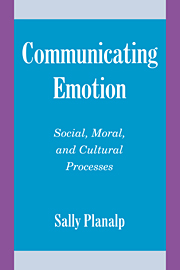Book contents
- Frontmatter
- Dedication
- Contents
- Acknowledgments
- Introduction
- 1 How Important Is Emotion in Everyday Interaction?
- 2 How and Why Is Emotion Communicated?
- 3 Is Emotional Communication Spontaneous or Strategic?
- 4 How Is Emotional Meaning Constructed Through Communication?
- 5 How Is Emotional Meaning Both Personal and Social?
- 6 How Do Emotion Messages Communicate Moral Meaning?
- 7 How Is Emotional Communication Grounded in Common Human Experience and Diverse Cultures?
- Epilogue: What is the Future of Emotional Meaning?
- References
- Author Index
- Subject Index
2 - How and Why Is Emotion Communicated?
Published online by Cambridge University Press: 05 February 2015
- Frontmatter
- Dedication
- Contents
- Acknowledgments
- Introduction
- 1 How Important Is Emotion in Everyday Interaction?
- 2 How and Why Is Emotion Communicated?
- 3 Is Emotional Communication Spontaneous or Strategic?
- 4 How Is Emotional Meaning Constructed Through Communication?
- 5 How Is Emotional Meaning Both Personal and Social?
- 6 How Do Emotion Messages Communicate Moral Meaning?
- 7 How Is Emotional Communication Grounded in Common Human Experience and Diverse Cultures?
- Epilogue: What is the Future of Emotional Meaning?
- References
- Author Index
- Subject Index
Summary
Sometimes a scream is better than a thesis.
Ralph Waldo EmersonAt first glance, communicating emotion seems easy. Foreigners, small children, and dogs seem to have no trouble picking up on fear or sadness (Plutchik, 1987; Thompson, 1987). Sometimes it takes only a quick look, a few words, or a subtle quality of the voice. But not all emotions are that simple or easy to communicate. How do you convey the emotions of the experience of childbirth or of being a prisoner of war? Simple words, tears, or screams fail. Even poetry does not quite seem to capture it. Even someone who has been through the same experience cannot fully understand yours. So emotion appears to be both easily expressed and inexpressible.
When you express your anger, I know what anger is, you know what anger is, and we communicate in ways that are standardized enough for me to know that you're expressing anger and not, for example, fear. Yet at the same time, your anger draws on your lifetime of experience, on your concerns, and on your goals, in ways that I cannot understand fully because I am not you. Thus the paradox. Notice that in setting up the paradox, I have introduced two theoretical perspectives on communication. The first is what we will call here communication as exchanging messages, and the second is communication as coordinating meaning.
Communication as Exchanging Messages
“If we could only communicate” is often heard, as if communication itself could fix all manner of problems. Or ''We have a breakdown in communication' as if a telephone line were down and all that is needed is for the line to be spliced back together again. This sort of everyday talk reflects a message exchange perspective on communication, or, put more crudely, a boxcar theory (Shannon & Weaver, 1949). According to this type of theory, information is loaded into a boxcar (encoded), sent on its way on some track (channel), and unloaded at the other end (decoded). If someone takes the trouble to send a message, things go fine so long as the track remains undamaged and free of obstructions (noise).
- Type
- Chapter
- Information
- Communicating EmotionSocial, Moral, and Cultural Processes, pp. 39 - 70Publisher: Cambridge University PressPrint publication year: 1999



